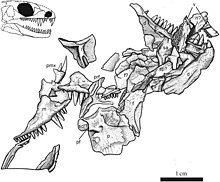Carbonodraco is an extinct genus of acleistorhinid parareptile known from the Late Carboniferous of Ohio. It contains a single species, Carbonodraco lundi. It was closely related to Colobomycter, a parareptile from the early Permian of Oklahoma. Carbonodraco is the oldest known parareptile, and is slightly older than Erpetonyx, the previously oldest known parareptile. Specimens of Carbonodraco are limited to skull and jaw fragments found at the Ohio Diamond Coal mine in Linton, Ohio. These include the holotype specimen (CM 23055, a crushed skull) and two referred specimens (NHMUK R. 2667, a right jaw; CM 81536, a pair of dentaries). Several of the Carbonodraco specimens were previously referred to the Carboniferous eureptile Cephalerpeton by Reisz & Baird (1983).[1] They were recognized as a distinct species in a 2019 study by Mann et al.[2]
| Carbonodraco Temporal range: Late Carboniferous (Pennsylvanian),
| |
|---|---|

| |
| Fossil diagram and skull restoration of the holotype skull | |

| |
| Life Restoration | |
| Scientific classification | |
| Domain: | Eukaryota |
| Kingdom: | Animalia |
| Phylum: | Chordata |
| Class: | Reptilia |
| Clade: | †Parareptilia |
| Order: | †Procolophonomorpha |
| Family: | †Acleistorhinidae |
| Genus: | †Carbonodraco Mann et al., 2019 |
| Type species | |
| †Carbonodraco lundi Mann et al., 2019
| |


References
edit- ^ Reisz, Robert R.; Baird, Donald (7 December 1983). "Captorhinomorph "stem" reptiles from the Pennsylvanian coal-swamp deposits of Linton, Ohio". Annals of the Carnegie Museum. 52 (18): 393–411.
- ^ Mann, Arjan; McDaniel, Emily J.; McColville, Emily R.; Maddin, Hillary C. (2019). "Carbonodraco lundi gen et sp. nov., the oldest parareptile, from Linton, Ohio, and new insights into the early radiation of reptiles". Royal Society Open Science. 6 (11): 191191. Bibcode:2019RSOS....691191M. doi:10.1098/rsos.191191. PMC 6894558. PMID 31827854.